Operation Management Strategies and Employee Motivation at Tesco Plc
VerifiedAdded on 2023/06/09
|13
|4135
|267
Report
AI Summary
This report provides an in-depth analysis of operation management at Tesco Plc, a British multinational retailer. It examines the role of operation management in achieving organizational objectives, focusing on aspects such as supply chain processes, tools and techniques, quality management, health and safety regulations, and innovation and technology. The report discusses contingency and operational management approaches, highlighting their importance in business development and growth. Furthermore, it analyzes the significance of motivation at the workplace, emphasizing its impact on employee performance, attitude, and the overall working environment. The report also explores how effective teamwork and communication enhance business performance, contributing to the achievement of company objectives. The analysis is supported by examples and insights into Tesco Plc's strategies and practices. Desklib provides access to this and other solved assignments for students.

REPORT
Paraphrase This Document
Need a fresh take? Get an instant paraphrase of this document with our AI Paraphraser
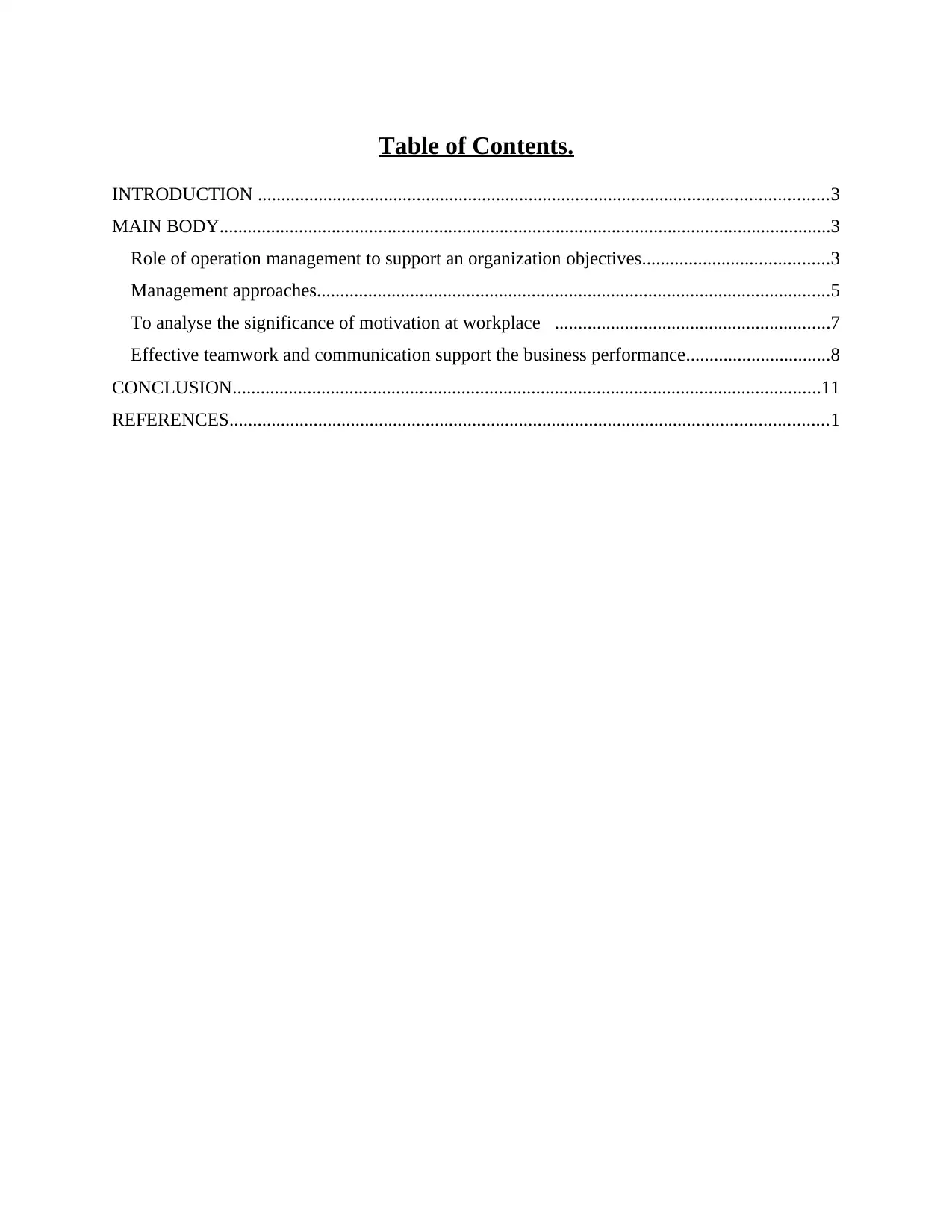
Table of Contents.
INTRODUCTION ..........................................................................................................................3
MAIN BODY...................................................................................................................................3
Role of operation management to support an organization objectives........................................3
Management approaches..............................................................................................................5
To analyse the significance of motivation at workplace ...........................................................7
Effective teamwork and communication support the business performance...............................8
CONCLUSION..............................................................................................................................11
REFERENCES................................................................................................................................1
INTRODUCTION ..........................................................................................................................3
MAIN BODY...................................................................................................................................3
Role of operation management to support an organization objectives........................................3
Management approaches..............................................................................................................5
To analyse the significance of motivation at workplace ...........................................................7
Effective teamwork and communication support the business performance...............................8
CONCLUSION..............................................................................................................................11
REFERENCES................................................................................................................................1
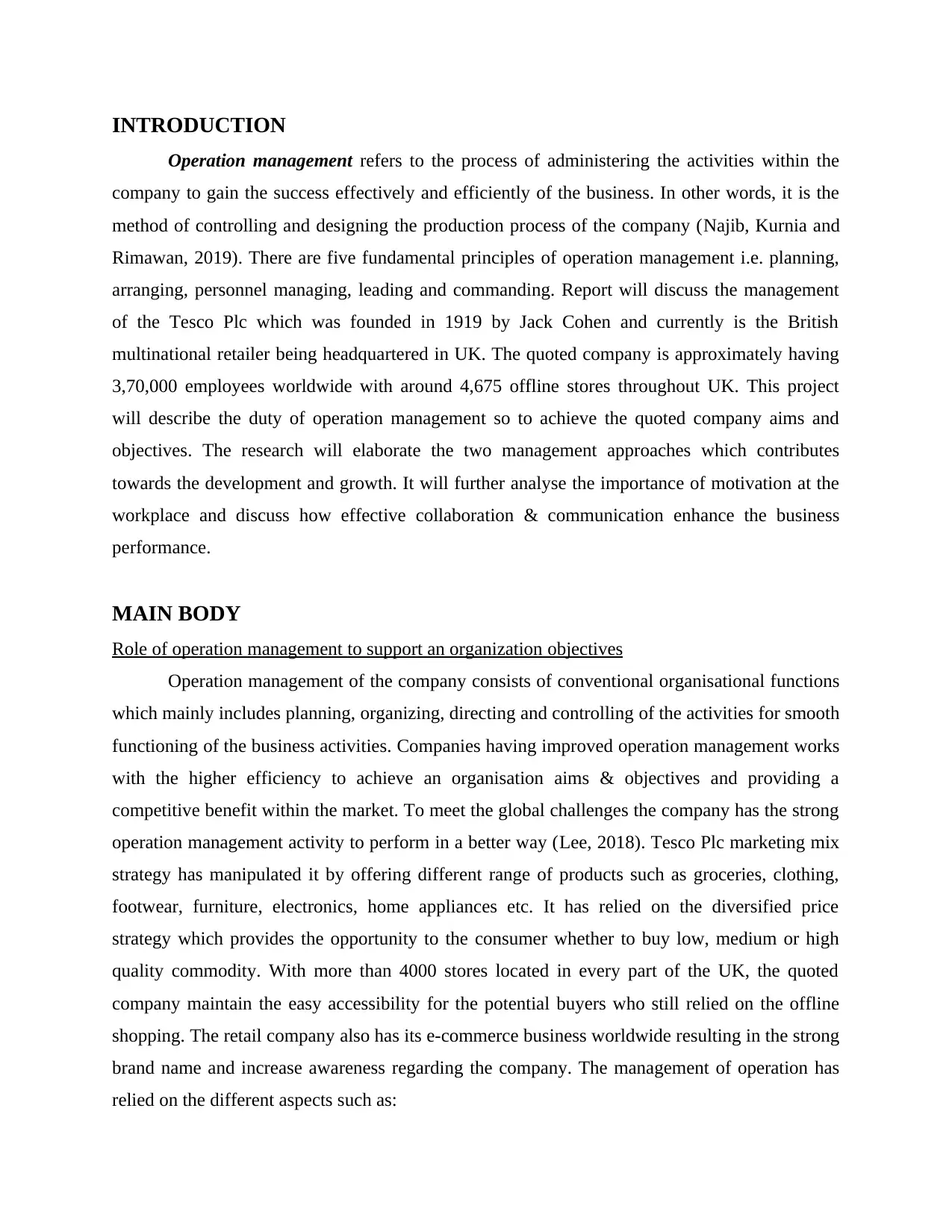
INTRODUCTION
Operation management refers to the process of administering the activities within the
company to gain the success effectively and efficiently of the business. In other words, it is the
method of controlling and designing the production process of the company (Najib, Kurnia and
Rimawan, 2019). There are five fundamental principles of operation management i.e. planning,
arranging, personnel managing, leading and commanding. Report will discuss the management
of the Tesco Plc which was founded in 1919 by Jack Cohen and currently is the British
multinational retailer being headquartered in UK. The quoted company is approximately having
3,70,000 employees worldwide with around 4,675 offline stores throughout UK. This project
will describe the duty of operation management so to achieve the quoted company aims and
objectives. The research will elaborate the two management approaches which contributes
towards the development and growth. It will further analyse the importance of motivation at the
workplace and discuss how effective collaboration & communication enhance the business
performance.
MAIN BODY
Role of operation management to support an organization objectives
Operation management of the company consists of conventional organisational functions
which mainly includes planning, organizing, directing and controlling of the activities for smooth
functioning of the business activities. Companies having improved operation management works
with the higher efficiency to achieve an organisation aims & objectives and providing a
competitive benefit within the market. To meet the global challenges the company has the strong
operation management activity to perform in a better way (Lee, 2018). Tesco Plc marketing mix
strategy has manipulated it by offering different range of products such as groceries, clothing,
footwear, furniture, electronics, home appliances etc. It has relied on the diversified price
strategy which provides the opportunity to the consumer whether to buy low, medium or high
quality commodity. With more than 4000 stores located in every part of the UK, the quoted
company maintain the easy accessibility for the potential buyers who still relied on the offline
shopping. The retail company also has its e-commerce business worldwide resulting in the strong
brand name and increase awareness regarding the company. The management of operation has
relied on the different aspects such as:
Operation management refers to the process of administering the activities within the
company to gain the success effectively and efficiently of the business. In other words, it is the
method of controlling and designing the production process of the company (Najib, Kurnia and
Rimawan, 2019). There are five fundamental principles of operation management i.e. planning,
arranging, personnel managing, leading and commanding. Report will discuss the management
of the Tesco Plc which was founded in 1919 by Jack Cohen and currently is the British
multinational retailer being headquartered in UK. The quoted company is approximately having
3,70,000 employees worldwide with around 4,675 offline stores throughout UK. This project
will describe the duty of operation management so to achieve the quoted company aims and
objectives. The research will elaborate the two management approaches which contributes
towards the development and growth. It will further analyse the importance of motivation at the
workplace and discuss how effective collaboration & communication enhance the business
performance.
MAIN BODY
Role of operation management to support an organization objectives
Operation management of the company consists of conventional organisational functions
which mainly includes planning, organizing, directing and controlling of the activities for smooth
functioning of the business activities. Companies having improved operation management works
with the higher efficiency to achieve an organisation aims & objectives and providing a
competitive benefit within the market. To meet the global challenges the company has the strong
operation management activity to perform in a better way (Lee, 2018). Tesco Plc marketing mix
strategy has manipulated it by offering different range of products such as groceries, clothing,
footwear, furniture, electronics, home appliances etc. It has relied on the diversified price
strategy which provides the opportunity to the consumer whether to buy low, medium or high
quality commodity. With more than 4000 stores located in every part of the UK, the quoted
company maintain the easy accessibility for the potential buyers who still relied on the offline
shopping. The retail company also has its e-commerce business worldwide resulting in the strong
brand name and increase awareness regarding the company. The management of operation has
relied on the different aspects such as:
⊘ This is a preview!⊘
Do you want full access?
Subscribe today to unlock all pages.

Trusted by 1+ million students worldwide
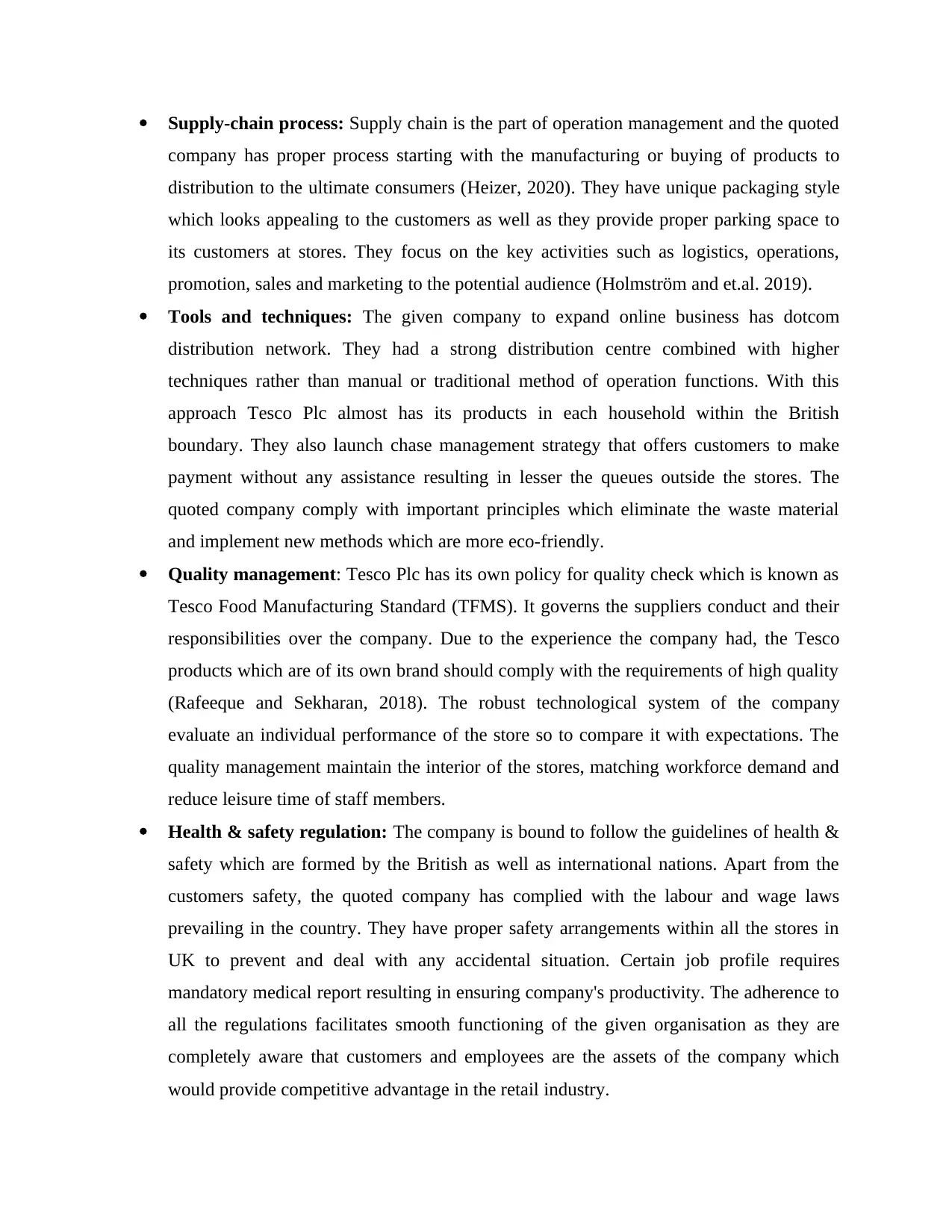
Supply-chain process: Supply chain is the part of operation management and the quoted
company has proper process starting with the manufacturing or buying of products to
distribution to the ultimate consumers (Heizer, 2020). They have unique packaging style
which looks appealing to the customers as well as they provide proper parking space to
its customers at stores. They focus on the key activities such as logistics, operations,
promotion, sales and marketing to the potential audience (Holmström and et.al. 2019).
Tools and techniques: The given company to expand online business has dotcom
distribution network. They had a strong distribution centre combined with higher
techniques rather than manual or traditional method of operation functions. With this
approach Tesco Plc almost has its products in each household within the British
boundary. They also launch chase management strategy that offers customers to make
payment without any assistance resulting in lesser the queues outside the stores. The
quoted company comply with important principles which eliminate the waste material
and implement new methods which are more eco-friendly.
Quality management: Tesco Plc has its own policy for quality check which is known as
Tesco Food Manufacturing Standard (TFMS). It governs the suppliers conduct and their
responsibilities over the company. Due to the experience the company had, the Tesco
products which are of its own brand should comply with the requirements of high quality
(Rafeeque and Sekharan, 2018). The robust technological system of the company
evaluate an individual performance of the store so to compare it with expectations. The
quality management maintain the interior of the stores, matching workforce demand and
reduce leisure time of staff members.
Health & safety regulation: The company is bound to follow the guidelines of health &
safety which are formed by the British as well as international nations. Apart from the
customers safety, the quoted company has complied with the labour and wage laws
prevailing in the country. They have proper safety arrangements within all the stores in
UK to prevent and deal with any accidental situation. Certain job profile requires
mandatory medical report resulting in ensuring company's productivity. The adherence to
all the regulations facilitates smooth functioning of the given organisation as they are
completely aware that customers and employees are the assets of the company which
would provide competitive advantage in the retail industry.
company has proper process starting with the manufacturing or buying of products to
distribution to the ultimate consumers (Heizer, 2020). They have unique packaging style
which looks appealing to the customers as well as they provide proper parking space to
its customers at stores. They focus on the key activities such as logistics, operations,
promotion, sales and marketing to the potential audience (Holmström and et.al. 2019).
Tools and techniques: The given company to expand online business has dotcom
distribution network. They had a strong distribution centre combined with higher
techniques rather than manual or traditional method of operation functions. With this
approach Tesco Plc almost has its products in each household within the British
boundary. They also launch chase management strategy that offers customers to make
payment without any assistance resulting in lesser the queues outside the stores. The
quoted company comply with important principles which eliminate the waste material
and implement new methods which are more eco-friendly.
Quality management: Tesco Plc has its own policy for quality check which is known as
Tesco Food Manufacturing Standard (TFMS). It governs the suppliers conduct and their
responsibilities over the company. Due to the experience the company had, the Tesco
products which are of its own brand should comply with the requirements of high quality
(Rafeeque and Sekharan, 2018). The robust technological system of the company
evaluate an individual performance of the store so to compare it with expectations. The
quality management maintain the interior of the stores, matching workforce demand and
reduce leisure time of staff members.
Health & safety regulation: The company is bound to follow the guidelines of health &
safety which are formed by the British as well as international nations. Apart from the
customers safety, the quoted company has complied with the labour and wage laws
prevailing in the country. They have proper safety arrangements within all the stores in
UK to prevent and deal with any accidental situation. Certain job profile requires
mandatory medical report resulting in ensuring company's productivity. The adherence to
all the regulations facilitates smooth functioning of the given organisation as they are
completely aware that customers and employees are the assets of the company which
would provide competitive advantage in the retail industry.
Paraphrase This Document
Need a fresh take? Get an instant paraphrase of this document with our AI Paraphraser
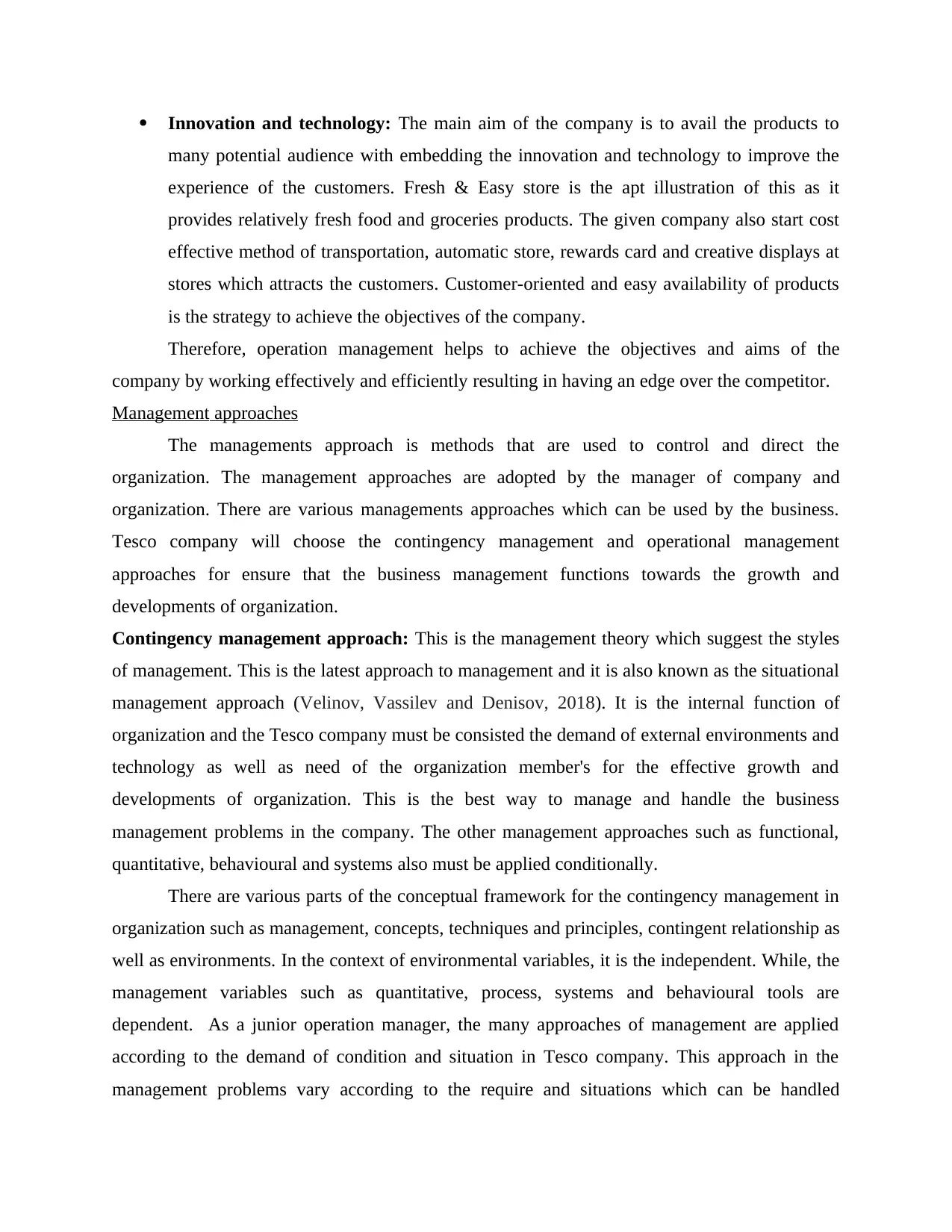
Innovation and technology: The main aim of the company is to avail the products to
many potential audience with embedding the innovation and technology to improve the
experience of the customers. Fresh & Easy store is the apt illustration of this as it
provides relatively fresh food and groceries products. The given company also start cost
effective method of transportation, automatic store, rewards card and creative displays at
stores which attracts the customers. Customer-oriented and easy availability of products
is the strategy to achieve the objectives of the company.
Therefore, operation management helps to achieve the objectives and aims of the
company by working effectively and efficiently resulting in having an edge over the competitor.
Management approaches
The managements approach is methods that are used to control and direct the
organization. The management approaches are adopted by the manager of company and
organization. There are various managements approaches which can be used by the business.
Tesco company will choose the contingency management and operational management
approaches for ensure that the business management functions towards the growth and
developments of organization.
Contingency management approach: This is the management theory which suggest the styles
of management. This is the latest approach to management and it is also known as the situational
management approach (Velinov, Vassilev and Denisov, 2018). It is the internal function of
organization and the Tesco company must be consisted the demand of external environments and
technology as well as need of the organization member's for the effective growth and
developments of organization. This is the best way to manage and handle the business
management problems in the company. The other management approaches such as functional,
quantitative, behavioural and systems also must be applied conditionally.
There are various parts of the conceptual framework for the contingency management in
organization such as management, concepts, techniques and principles, contingent relationship as
well as environments. In the context of environmental variables, it is the independent. While, the
management variables such as quantitative, process, systems and behavioural tools are
dependent. As a junior operation manager, the many approaches of management are applied
according to the demand of condition and situation in Tesco company. This approach in the
management problems vary according to the require and situations which can be handled
many potential audience with embedding the innovation and technology to improve the
experience of the customers. Fresh & Easy store is the apt illustration of this as it
provides relatively fresh food and groceries products. The given company also start cost
effective method of transportation, automatic store, rewards card and creative displays at
stores which attracts the customers. Customer-oriented and easy availability of products
is the strategy to achieve the objectives of the company.
Therefore, operation management helps to achieve the objectives and aims of the
company by working effectively and efficiently resulting in having an edge over the competitor.
Management approaches
The managements approach is methods that are used to control and direct the
organization. The management approaches are adopted by the manager of company and
organization. There are various managements approaches which can be used by the business.
Tesco company will choose the contingency management and operational management
approaches for ensure that the business management functions towards the growth and
developments of organization.
Contingency management approach: This is the management theory which suggest the styles
of management. This is the latest approach to management and it is also known as the situational
management approach (Velinov, Vassilev and Denisov, 2018). It is the internal function of
organization and the Tesco company must be consisted the demand of external environments and
technology as well as need of the organization member's for the effective growth and
developments of organization. This is the best way to manage and handle the business
management problems in the company. The other management approaches such as functional,
quantitative, behavioural and systems also must be applied conditionally.
There are various parts of the conceptual framework for the contingency management in
organization such as management, concepts, techniques and principles, contingent relationship as
well as environments. In the context of environmental variables, it is the independent. While, the
management variables such as quantitative, process, systems and behavioural tools are
dependent. As a junior operation manager, the many approaches of management are applied
according to the demand of condition and situation in Tesco company. This approach in the
management problems vary according to the require and situations which can be handled
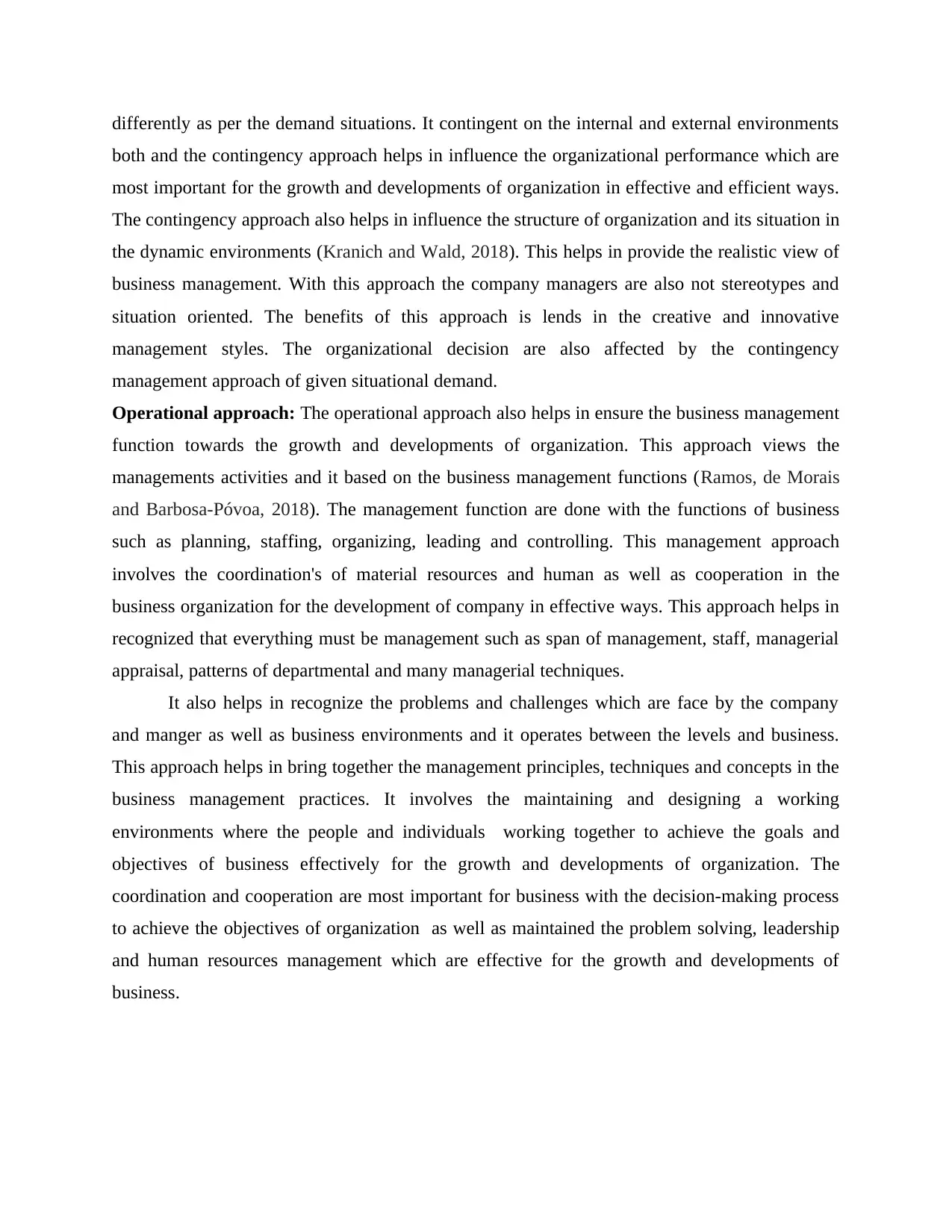
differently as per the demand situations. It contingent on the internal and external environments
both and the contingency approach helps in influence the organizational performance which are
most important for the growth and developments of organization in effective and efficient ways.
The contingency approach also helps in influence the structure of organization and its situation in
the dynamic environments (Kranich and Wald, 2018). This helps in provide the realistic view of
business management. With this approach the company managers are also not stereotypes and
situation oriented. The benefits of this approach is lends in the creative and innovative
management styles. The organizational decision are also affected by the contingency
management approach of given situational demand.
Operational approach: The operational approach also helps in ensure the business management
function towards the growth and developments of organization. This approach views the
managements activities and it based on the business management functions (Ramos, de Morais
and Barbosa-Póvoa, 2018). The management function are done with the functions of business
such as planning, staffing, organizing, leading and controlling. This management approach
involves the coordination's of material resources and human as well as cooperation in the
business organization for the development of company in effective ways. This approach helps in
recognized that everything must be management such as span of management, staff, managerial
appraisal, patterns of departmental and many managerial techniques.
It also helps in recognize the problems and challenges which are face by the company
and manger as well as business environments and it operates between the levels and business.
This approach helps in bring together the management principles, techniques and concepts in the
business management practices. It involves the maintaining and designing a working
environments where the people and individuals working together to achieve the goals and
objectives of business effectively for the growth and developments of organization. The
coordination and cooperation are most important for business with the decision-making process
to achieve the objectives of organization as well as maintained the problem solving, leadership
and human resources management which are effective for the growth and developments of
business.
both and the contingency approach helps in influence the organizational performance which are
most important for the growth and developments of organization in effective and efficient ways.
The contingency approach also helps in influence the structure of organization and its situation in
the dynamic environments (Kranich and Wald, 2018). This helps in provide the realistic view of
business management. With this approach the company managers are also not stereotypes and
situation oriented. The benefits of this approach is lends in the creative and innovative
management styles. The organizational decision are also affected by the contingency
management approach of given situational demand.
Operational approach: The operational approach also helps in ensure the business management
function towards the growth and developments of organization. This approach views the
managements activities and it based on the business management functions (Ramos, de Morais
and Barbosa-Póvoa, 2018). The management function are done with the functions of business
such as planning, staffing, organizing, leading and controlling. This management approach
involves the coordination's of material resources and human as well as cooperation in the
business organization for the development of company in effective ways. This approach helps in
recognized that everything must be management such as span of management, staff, managerial
appraisal, patterns of departmental and many managerial techniques.
It also helps in recognize the problems and challenges which are face by the company
and manger as well as business environments and it operates between the levels and business.
This approach helps in bring together the management principles, techniques and concepts in the
business management practices. It involves the maintaining and designing a working
environments where the people and individuals working together to achieve the goals and
objectives of business effectively for the growth and developments of organization. The
coordination and cooperation are most important for business with the decision-making process
to achieve the objectives of organization as well as maintained the problem solving, leadership
and human resources management which are effective for the growth and developments of
business.
⊘ This is a preview!⊘
Do you want full access?
Subscribe today to unlock all pages.

Trusted by 1+ million students worldwide
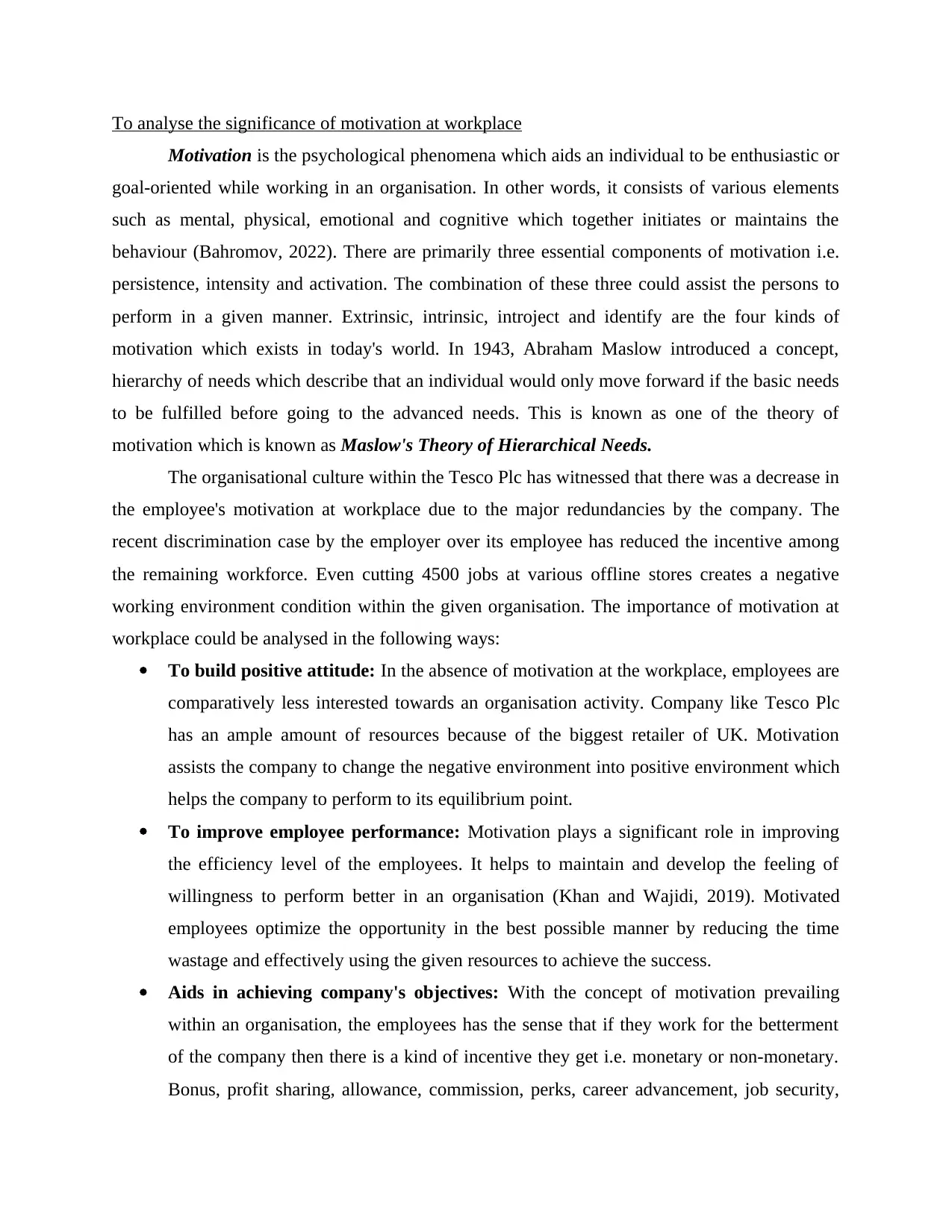
To analyse the significance of motivation at workplace
Motivation is the psychological phenomena which aids an individual to be enthusiastic or
goal-oriented while working in an organisation. In other words, it consists of various elements
such as mental, physical, emotional and cognitive which together initiates or maintains the
behaviour (Bahromov, 2022). There are primarily three essential components of motivation i.e.
persistence, intensity and activation. The combination of these three could assist the persons to
perform in a given manner. Extrinsic, intrinsic, introject and identify are the four kinds of
motivation which exists in today's world. In 1943, Abraham Maslow introduced a concept,
hierarchy of needs which describe that an individual would only move forward if the basic needs
to be fulfilled before going to the advanced needs. This is known as one of the theory of
motivation which is known as Maslow's Theory of Hierarchical Needs.
The organisational culture within the Tesco Plc has witnessed that there was a decrease in
the employee's motivation at workplace due to the major redundancies by the company. The
recent discrimination case by the employer over its employee has reduced the incentive among
the remaining workforce. Even cutting 4500 jobs at various offline stores creates a negative
working environment condition within the given organisation. The importance of motivation at
workplace could be analysed in the following ways:
To build positive attitude: In the absence of motivation at the workplace, employees are
comparatively less interested towards an organisation activity. Company like Tesco Plc
has an ample amount of resources because of the biggest retailer of UK. Motivation
assists the company to change the negative environment into positive environment which
helps the company to perform to its equilibrium point.
To improve employee performance: Motivation plays a significant role in improving
the efficiency level of the employees. It helps to maintain and develop the feeling of
willingness to perform better in an organisation (Khan and Wajidi, 2019). Motivated
employees optimize the opportunity in the best possible manner by reducing the time
wastage and effectively using the given resources to achieve the success.
Aids in achieving company's objectives: With the concept of motivation prevailing
within an organisation, the employees has the sense that if they work for the betterment
of the company then there is a kind of incentive they get i.e. monetary or non-monetary.
Bonus, profit sharing, allowance, commission, perks, career advancement, job security,
Motivation is the psychological phenomena which aids an individual to be enthusiastic or
goal-oriented while working in an organisation. In other words, it consists of various elements
such as mental, physical, emotional and cognitive which together initiates or maintains the
behaviour (Bahromov, 2022). There are primarily three essential components of motivation i.e.
persistence, intensity and activation. The combination of these three could assist the persons to
perform in a given manner. Extrinsic, intrinsic, introject and identify are the four kinds of
motivation which exists in today's world. In 1943, Abraham Maslow introduced a concept,
hierarchy of needs which describe that an individual would only move forward if the basic needs
to be fulfilled before going to the advanced needs. This is known as one of the theory of
motivation which is known as Maslow's Theory of Hierarchical Needs.
The organisational culture within the Tesco Plc has witnessed that there was a decrease in
the employee's motivation at workplace due to the major redundancies by the company. The
recent discrimination case by the employer over its employee has reduced the incentive among
the remaining workforce. Even cutting 4500 jobs at various offline stores creates a negative
working environment condition within the given organisation. The importance of motivation at
workplace could be analysed in the following ways:
To build positive attitude: In the absence of motivation at the workplace, employees are
comparatively less interested towards an organisation activity. Company like Tesco Plc
has an ample amount of resources because of the biggest retailer of UK. Motivation
assists the company to change the negative environment into positive environment which
helps the company to perform to its equilibrium point.
To improve employee performance: Motivation plays a significant role in improving
the efficiency level of the employees. It helps to maintain and develop the feeling of
willingness to perform better in an organisation (Khan and Wajidi, 2019). Motivated
employees optimize the opportunity in the best possible manner by reducing the time
wastage and effectively using the given resources to achieve the success.
Aids in achieving company's objectives: With the concept of motivation prevailing
within an organisation, the employees has the sense that if they work for the betterment
of the company then there is a kind of incentive they get i.e. monetary or non-monetary.
Bonus, profit sharing, allowance, commission, perks, career advancement, job security,
Paraphrase This Document
Need a fresh take? Get an instant paraphrase of this document with our AI Paraphraser
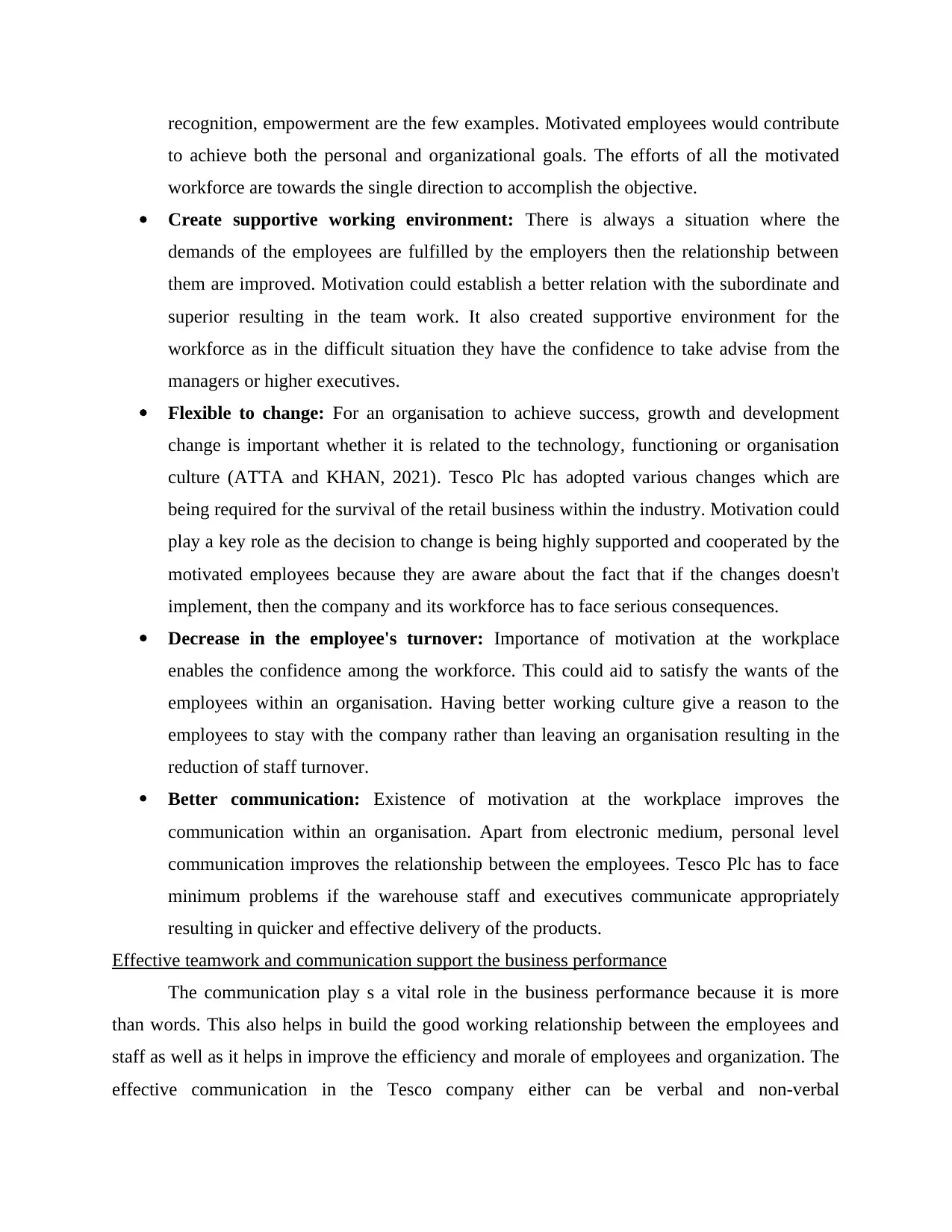
recognition, empowerment are the few examples. Motivated employees would contribute
to achieve both the personal and organizational goals. The efforts of all the motivated
workforce are towards the single direction to accomplish the objective.
Create supportive working environment: There is always a situation where the
demands of the employees are fulfilled by the employers then the relationship between
them are improved. Motivation could establish a better relation with the subordinate and
superior resulting in the team work. It also created supportive environment for the
workforce as in the difficult situation they have the confidence to take advise from the
managers or higher executives.
Flexible to change: For an organisation to achieve success, growth and development
change is important whether it is related to the technology, functioning or organisation
culture (ATTA and KHAN, 2021). Tesco Plc has adopted various changes which are
being required for the survival of the retail business within the industry. Motivation could
play a key role as the decision to change is being highly supported and cooperated by the
motivated employees because they are aware about the fact that if the changes doesn't
implement, then the company and its workforce has to face serious consequences.
Decrease in the employee's turnover: Importance of motivation at the workplace
enables the confidence among the workforce. This could aid to satisfy the wants of the
employees within an organisation. Having better working culture give a reason to the
employees to stay with the company rather than leaving an organisation resulting in the
reduction of staff turnover.
Better communication: Existence of motivation at the workplace improves the
communication within an organisation. Apart from electronic medium, personal level
communication improves the relationship between the employees. Tesco Plc has to face
minimum problems if the warehouse staff and executives communicate appropriately
resulting in quicker and effective delivery of the products.
Effective teamwork and communication support the business performance
The communication play s a vital role in the business performance because it is more
than words. This also helps in build the good working relationship between the employees and
staff as well as it helps in improve the efficiency and morale of employees and organization. The
effective communication in the Tesco company either can be verbal and non-verbal
to achieve both the personal and organizational goals. The efforts of all the motivated
workforce are towards the single direction to accomplish the objective.
Create supportive working environment: There is always a situation where the
demands of the employees are fulfilled by the employers then the relationship between
them are improved. Motivation could establish a better relation with the subordinate and
superior resulting in the team work. It also created supportive environment for the
workforce as in the difficult situation they have the confidence to take advise from the
managers or higher executives.
Flexible to change: For an organisation to achieve success, growth and development
change is important whether it is related to the technology, functioning or organisation
culture (ATTA and KHAN, 2021). Tesco Plc has adopted various changes which are
being required for the survival of the retail business within the industry. Motivation could
play a key role as the decision to change is being highly supported and cooperated by the
motivated employees because they are aware about the fact that if the changes doesn't
implement, then the company and its workforce has to face serious consequences.
Decrease in the employee's turnover: Importance of motivation at the workplace
enables the confidence among the workforce. This could aid to satisfy the wants of the
employees within an organisation. Having better working culture give a reason to the
employees to stay with the company rather than leaving an organisation resulting in the
reduction of staff turnover.
Better communication: Existence of motivation at the workplace improves the
communication within an organisation. Apart from electronic medium, personal level
communication improves the relationship between the employees. Tesco Plc has to face
minimum problems if the warehouse staff and executives communicate appropriately
resulting in quicker and effective delivery of the products.
Effective teamwork and communication support the business performance
The communication play s a vital role in the business performance because it is more
than words. This also helps in build the good working relationship between the employees and
staff as well as it helps in improve the efficiency and morale of employees and organization. The
effective communication in the Tesco company either can be verbal and non-verbal
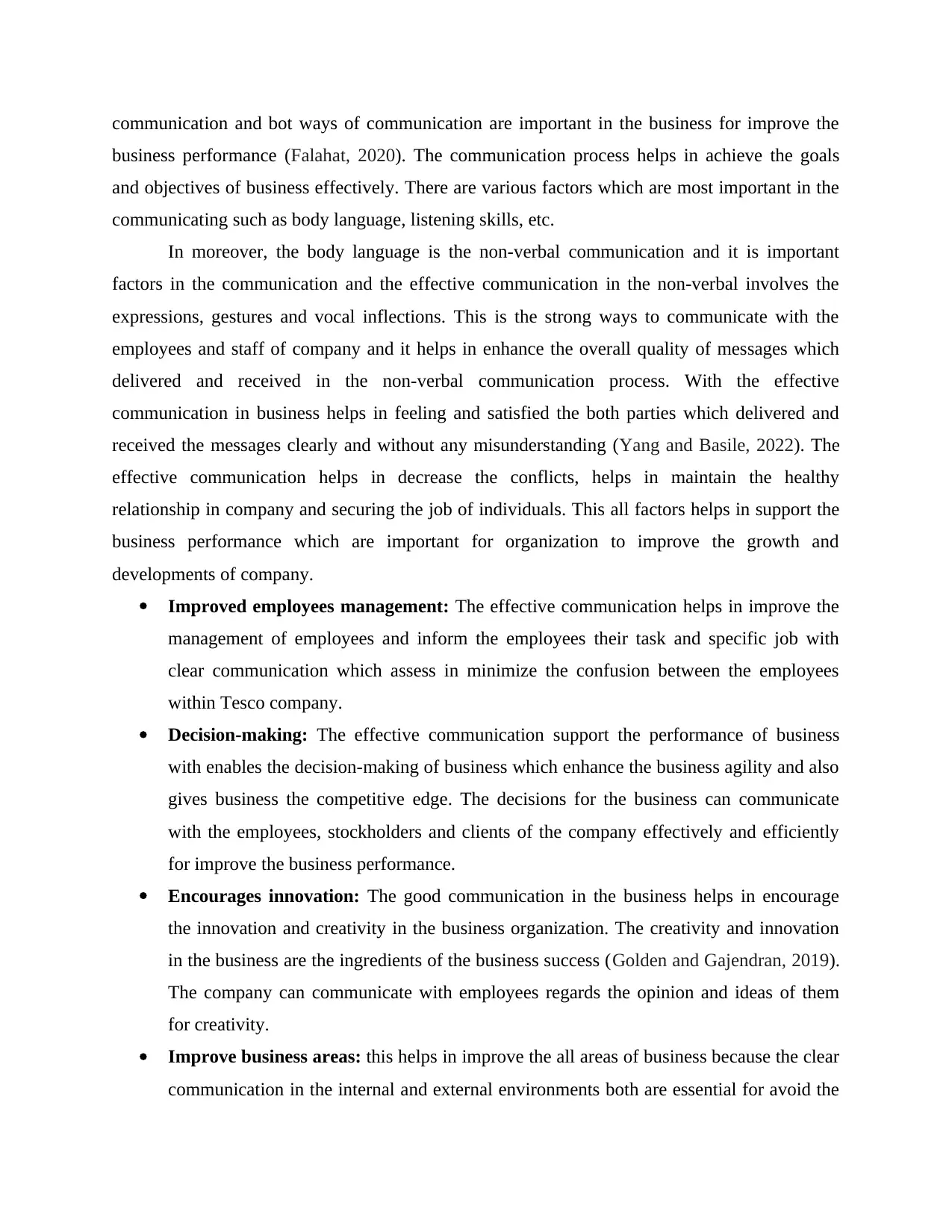
communication and bot ways of communication are important in the business for improve the
business performance (Falahat, 2020). The communication process helps in achieve the goals
and objectives of business effectively. There are various factors which are most important in the
communicating such as body language, listening skills, etc.
In moreover, the body language is the non-verbal communication and it is important
factors in the communication and the effective communication in the non-verbal involves the
expressions, gestures and vocal inflections. This is the strong ways to communicate with the
employees and staff of company and it helps in enhance the overall quality of messages which
delivered and received in the non-verbal communication process. With the effective
communication in business helps in feeling and satisfied the both parties which delivered and
received the messages clearly and without any misunderstanding (Yang and Basile, 2022). The
effective communication helps in decrease the conflicts, helps in maintain the healthy
relationship in company and securing the job of individuals. This all factors helps in support the
business performance which are important for organization to improve the growth and
developments of company.
Improved employees management: The effective communication helps in improve the
management of employees and inform the employees their task and specific job with
clear communication which assess in minimize the confusion between the employees
within Tesco company.
Decision-making: The effective communication support the performance of business
with enables the decision-making of business which enhance the business agility and also
gives business the competitive edge. The decisions for the business can communicate
with the employees, stockholders and clients of the company effectively and efficiently
for improve the business performance.
Encourages innovation: The good communication in the business helps in encourage
the innovation and creativity in the business organization. The creativity and innovation
in the business are the ingredients of the business success (Golden and Gajendran, 2019).
The company can communicate with employees regards the opinion and ideas of them
for creativity.
Improve business areas: this helps in improve the all areas of business because the clear
communication in the internal and external environments both are essential for avoid the
business performance (Falahat, 2020). The communication process helps in achieve the goals
and objectives of business effectively. There are various factors which are most important in the
communicating such as body language, listening skills, etc.
In moreover, the body language is the non-verbal communication and it is important
factors in the communication and the effective communication in the non-verbal involves the
expressions, gestures and vocal inflections. This is the strong ways to communicate with the
employees and staff of company and it helps in enhance the overall quality of messages which
delivered and received in the non-verbal communication process. With the effective
communication in business helps in feeling and satisfied the both parties which delivered and
received the messages clearly and without any misunderstanding (Yang and Basile, 2022). The
effective communication helps in decrease the conflicts, helps in maintain the healthy
relationship in company and securing the job of individuals. This all factors helps in support the
business performance which are important for organization to improve the growth and
developments of company.
Improved employees management: The effective communication helps in improve the
management of employees and inform the employees their task and specific job with
clear communication which assess in minimize the confusion between the employees
within Tesco company.
Decision-making: The effective communication support the performance of business
with enables the decision-making of business which enhance the business agility and also
gives business the competitive edge. The decisions for the business can communicate
with the employees, stockholders and clients of the company effectively and efficiently
for improve the business performance.
Encourages innovation: The good communication in the business helps in encourage
the innovation and creativity in the business organization. The creativity and innovation
in the business are the ingredients of the business success (Golden and Gajendran, 2019).
The company can communicate with employees regards the opinion and ideas of them
for creativity.
Improve business areas: this helps in improve the all areas of business because the clear
communication in the internal and external environments both are essential for avoid the
⊘ This is a preview!⊘
Do you want full access?
Subscribe today to unlock all pages.

Trusted by 1+ million students worldwide
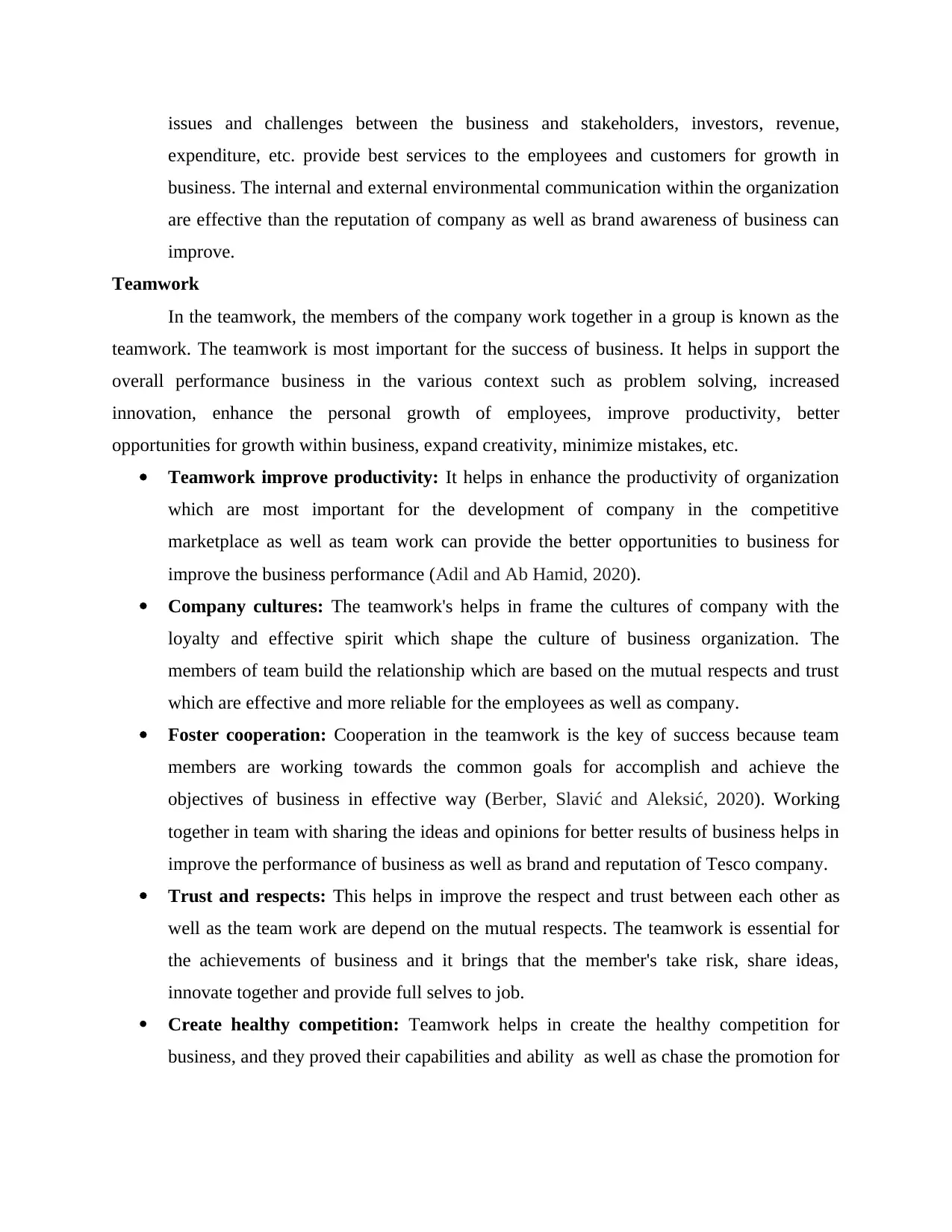
issues and challenges between the business and stakeholders, investors, revenue,
expenditure, etc. provide best services to the employees and customers for growth in
business. The internal and external environmental communication within the organization
are effective than the reputation of company as well as brand awareness of business can
improve.
Teamwork
In the teamwork, the members of the company work together in a group is known as the
teamwork. The teamwork is most important for the success of business. It helps in support the
overall performance business in the various context such as problem solving, increased
innovation, enhance the personal growth of employees, improve productivity, better
opportunities for growth within business, expand creativity, minimize mistakes, etc.
Teamwork improve productivity: It helps in enhance the productivity of organization
which are most important for the development of company in the competitive
marketplace as well as team work can provide the better opportunities to business for
improve the business performance (Adil and Ab Hamid, 2020).
Company cultures: The teamwork's helps in frame the cultures of company with the
loyalty and effective spirit which shape the culture of business organization. The
members of team build the relationship which are based on the mutual respects and trust
which are effective and more reliable for the employees as well as company.
Foster cooperation: Cooperation in the teamwork is the key of success because team
members are working towards the common goals for accomplish and achieve the
objectives of business in effective way (Berber, Slavić and Aleksić, 2020). Working
together in team with sharing the ideas and opinions for better results of business helps in
improve the performance of business as well as brand and reputation of Tesco company.
Trust and respects: This helps in improve the respect and trust between each other as
well as the team work are depend on the mutual respects. The teamwork is essential for
the achievements of business and it brings that the member's take risk, share ideas,
innovate together and provide full selves to job.
Create healthy competition: Teamwork helps in create the healthy competition for
business, and they proved their capabilities and ability as well as chase the promotion for
expenditure, etc. provide best services to the employees and customers for growth in
business. The internal and external environmental communication within the organization
are effective than the reputation of company as well as brand awareness of business can
improve.
Teamwork
In the teamwork, the members of the company work together in a group is known as the
teamwork. The teamwork is most important for the success of business. It helps in support the
overall performance business in the various context such as problem solving, increased
innovation, enhance the personal growth of employees, improve productivity, better
opportunities for growth within business, expand creativity, minimize mistakes, etc.
Teamwork improve productivity: It helps in enhance the productivity of organization
which are most important for the development of company in the competitive
marketplace as well as team work can provide the better opportunities to business for
improve the business performance (Adil and Ab Hamid, 2020).
Company cultures: The teamwork's helps in frame the cultures of company with the
loyalty and effective spirit which shape the culture of business organization. The
members of team build the relationship which are based on the mutual respects and trust
which are effective and more reliable for the employees as well as company.
Foster cooperation: Cooperation in the teamwork is the key of success because team
members are working towards the common goals for accomplish and achieve the
objectives of business in effective way (Berber, Slavić and Aleksić, 2020). Working
together in team with sharing the ideas and opinions for better results of business helps in
improve the performance of business as well as brand and reputation of Tesco company.
Trust and respects: This helps in improve the respect and trust between each other as
well as the team work are depend on the mutual respects. The teamwork is essential for
the achievements of business and it brings that the member's take risk, share ideas,
innovate together and provide full selves to job.
Create healthy competition: Teamwork helps in create the healthy competition for
business, and they proved their capabilities and ability as well as chase the promotion for
Paraphrase This Document
Need a fresh take? Get an instant paraphrase of this document with our AI Paraphraser
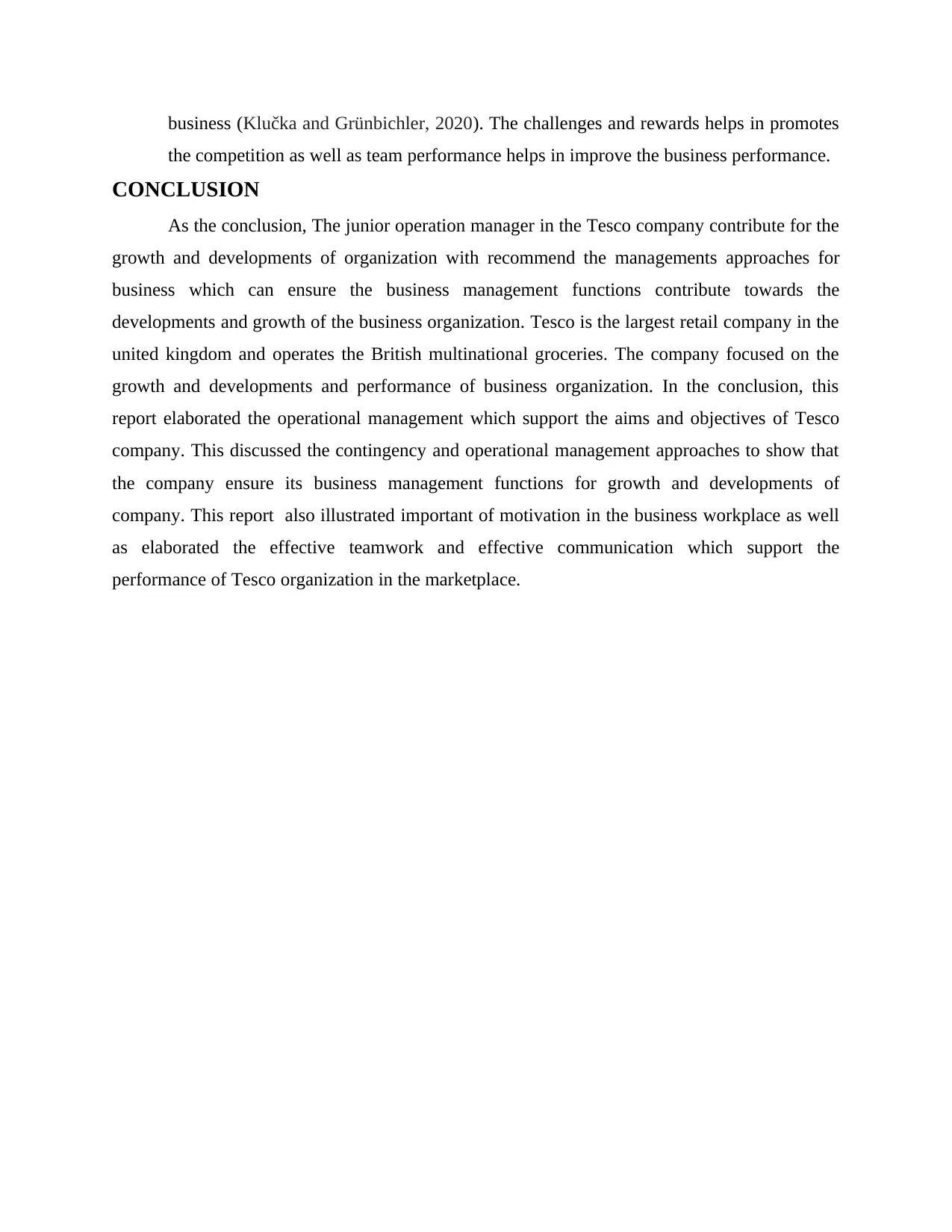
business (Klučka and Grünbichler, 2020). The challenges and rewards helps in promotes
the competition as well as team performance helps in improve the business performance.
CONCLUSION
As the conclusion, The junior operation manager in the Tesco company contribute for the
growth and developments of organization with recommend the managements approaches for
business which can ensure the business management functions contribute towards the
developments and growth of the business organization. Tesco is the largest retail company in the
united kingdom and operates the British multinational groceries. The company focused on the
growth and developments and performance of business organization. In the conclusion, this
report elaborated the operational management which support the aims and objectives of Tesco
company. This discussed the contingency and operational management approaches to show that
the company ensure its business management functions for growth and developments of
company. This report also illustrated important of motivation in the business workplace as well
as elaborated the effective teamwork and effective communication which support the
performance of Tesco organization in the marketplace.
the competition as well as team performance helps in improve the business performance.
CONCLUSION
As the conclusion, The junior operation manager in the Tesco company contribute for the
growth and developments of organization with recommend the managements approaches for
business which can ensure the business management functions contribute towards the
developments and growth of the business organization. Tesco is the largest retail company in the
united kingdom and operates the British multinational groceries. The company focused on the
growth and developments and performance of business organization. In the conclusion, this
report elaborated the operational management which support the aims and objectives of Tesco
company. This discussed the contingency and operational management approaches to show that
the company ensure its business management functions for growth and developments of
company. This report also illustrated important of motivation in the business workplace as well
as elaborated the effective teamwork and effective communication which support the
performance of Tesco organization in the marketplace.
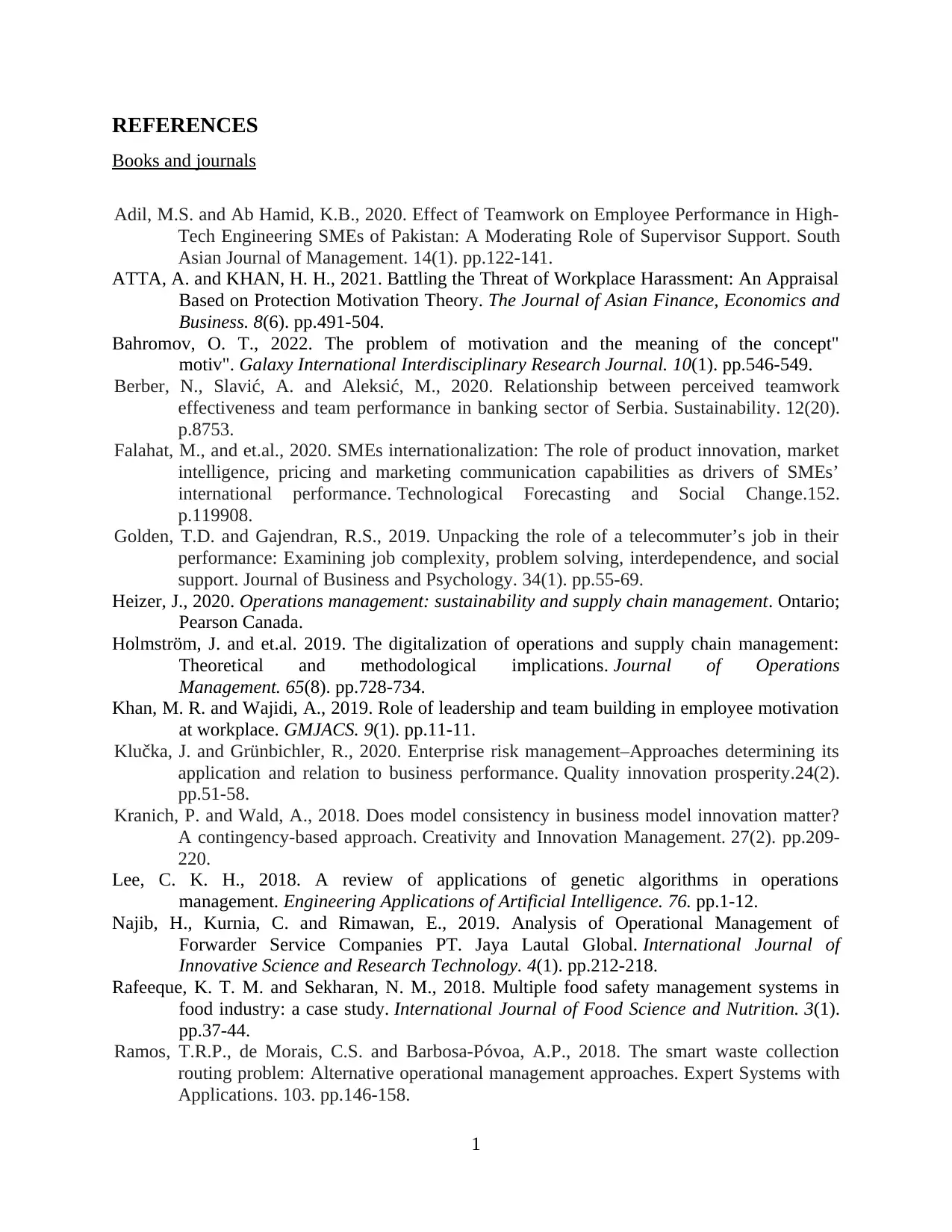
REFERENCES
Books and journals
Adil, M.S. and Ab Hamid, K.B., 2020. Effect of Teamwork on Employee Performance in High-
Tech Engineering SMEs of Pakistan: A Moderating Role of Supervisor Support. South
Asian Journal of Management. 14(1). pp.122-141.
ATTA, A. and KHAN, H. H., 2021. Battling the Threat of Workplace Harassment: An Appraisal
Based on Protection Motivation Theory. The Journal of Asian Finance, Economics and
Business. 8(6). pp.491-504.
Bahromov, O. T., 2022. The problem of motivation and the meaning of the concept"
motiv". Galaxy International Interdisciplinary Research Journal. 10(1). pp.546-549.
Berber, N., Slavić, A. and Aleksić, M., 2020. Relationship between perceived teamwork
effectiveness and team performance in banking sector of Serbia. Sustainability. 12(20).
p.8753.
Falahat, M., and et.al., 2020. SMEs internationalization: The role of product innovation, market
intelligence, pricing and marketing communication capabilities as drivers of SMEs’
international performance. Technological Forecasting and Social Change.152.
p.119908.
Golden, T.D. and Gajendran, R.S., 2019. Unpacking the role of a telecommuter’s job in their
performance: Examining job complexity, problem solving, interdependence, and social
support. Journal of Business and Psychology. 34(1). pp.55-69.
Heizer, J., 2020. Operations management: sustainability and supply chain management. Ontario;
Pearson Canada.
Holmström, J. and et.al. 2019. The digitalization of operations and supply chain management:
Theoretical and methodological implications. Journal of Operations
Management. 65(8). pp.728-734.
Khan, M. R. and Wajidi, A., 2019. Role of leadership and team building in employee motivation
at workplace. GMJACS. 9(1). pp.11-11.
Klučka, J. and Grünbichler, R., 2020. Enterprise risk management–Approaches determining its
application and relation to business performance. Quality innovation prosperity.24(2).
pp.51-58.
Kranich, P. and Wald, A., 2018. Does model consistency in business model innovation matter?
A contingency‐based approach. Creativity and Innovation Management. 27(2). pp.209-
220.
Lee, C. K. H., 2018. A review of applications of genetic algorithms in operations
management. Engineering Applications of Artificial Intelligence. 76. pp.1-12.
Najib, H., Kurnia, C. and Rimawan, E., 2019. Analysis of Operational Management of
Forwarder Service Companies PT. Jaya Lautal Global. International Journal of
Innovative Science and Research Technology. 4(1). pp.212-218.
Rafeeque, K. T. M. and Sekharan, N. M., 2018. Multiple food safety management systems in
food industry: a case study. International Journal of Food Science and Nutrition. 3(1).
pp.37-44.
Ramos, T.R.P., de Morais, C.S. and Barbosa-Póvoa, A.P., 2018. The smart waste collection
routing problem: Alternative operational management approaches. Expert Systems with
Applications. 103. pp.146-158.
1
Books and journals
Adil, M.S. and Ab Hamid, K.B., 2020. Effect of Teamwork on Employee Performance in High-
Tech Engineering SMEs of Pakistan: A Moderating Role of Supervisor Support. South
Asian Journal of Management. 14(1). pp.122-141.
ATTA, A. and KHAN, H. H., 2021. Battling the Threat of Workplace Harassment: An Appraisal
Based on Protection Motivation Theory. The Journal of Asian Finance, Economics and
Business. 8(6). pp.491-504.
Bahromov, O. T., 2022. The problem of motivation and the meaning of the concept"
motiv". Galaxy International Interdisciplinary Research Journal. 10(1). pp.546-549.
Berber, N., Slavić, A. and Aleksić, M., 2020. Relationship between perceived teamwork
effectiveness and team performance in banking sector of Serbia. Sustainability. 12(20).
p.8753.
Falahat, M., and et.al., 2020. SMEs internationalization: The role of product innovation, market
intelligence, pricing and marketing communication capabilities as drivers of SMEs’
international performance. Technological Forecasting and Social Change.152.
p.119908.
Golden, T.D. and Gajendran, R.S., 2019. Unpacking the role of a telecommuter’s job in their
performance: Examining job complexity, problem solving, interdependence, and social
support. Journal of Business and Psychology. 34(1). pp.55-69.
Heizer, J., 2020. Operations management: sustainability and supply chain management. Ontario;
Pearson Canada.
Holmström, J. and et.al. 2019. The digitalization of operations and supply chain management:
Theoretical and methodological implications. Journal of Operations
Management. 65(8). pp.728-734.
Khan, M. R. and Wajidi, A., 2019. Role of leadership and team building in employee motivation
at workplace. GMJACS. 9(1). pp.11-11.
Klučka, J. and Grünbichler, R., 2020. Enterprise risk management–Approaches determining its
application and relation to business performance. Quality innovation prosperity.24(2).
pp.51-58.
Kranich, P. and Wald, A., 2018. Does model consistency in business model innovation matter?
A contingency‐based approach. Creativity and Innovation Management. 27(2). pp.209-
220.
Lee, C. K. H., 2018. A review of applications of genetic algorithms in operations
management. Engineering Applications of Artificial Intelligence. 76. pp.1-12.
Najib, H., Kurnia, C. and Rimawan, E., 2019. Analysis of Operational Management of
Forwarder Service Companies PT. Jaya Lautal Global. International Journal of
Innovative Science and Research Technology. 4(1). pp.212-218.
Rafeeque, K. T. M. and Sekharan, N. M., 2018. Multiple food safety management systems in
food industry: a case study. International Journal of Food Science and Nutrition. 3(1).
pp.37-44.
Ramos, T.R.P., de Morais, C.S. and Barbosa-Póvoa, A.P., 2018. The smart waste collection
routing problem: Alternative operational management approaches. Expert Systems with
Applications. 103. pp.146-158.
1
⊘ This is a preview!⊘
Do you want full access?
Subscribe today to unlock all pages.

Trusted by 1+ million students worldwide
1 out of 13
Related Documents
Your All-in-One AI-Powered Toolkit for Academic Success.
+13062052269
info@desklib.com
Available 24*7 on WhatsApp / Email
![[object Object]](/_next/static/media/star-bottom.7253800d.svg)
Unlock your academic potential
Copyright © 2020–2025 A2Z Services. All Rights Reserved. Developed and managed by ZUCOL.





